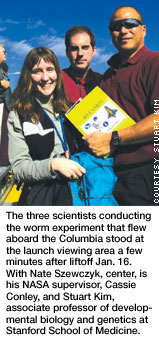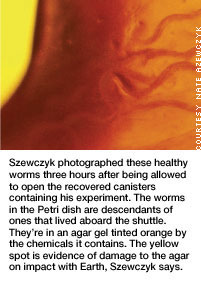 |
|
 |
||
|
|
|
|||
|
 Worms Survive Shuttle Disaster � A routine experiment conducted by alumnus Nate Szewczyk and other researchers speaks to the origins of life on Earth. � By Ruth Hammond
The worm experiment postdoctoral researcher Nate Szewczyk and his colleagues at NASA sent up on the shuttle Columbia last January was supposed to be routine. They wanted to see if the tiny worms, known as C. elegans, would grow if fed a synthetic nutrient during the flight.
"So it went from being something pretty ordinary to something pretty important," Szewczyk (pronounced SHEV-check) said. On Feb. 1, Szewczyk was at Kennedy Space Center in Florida awaiting the return of his experiment. It would have been the first time he witnessed a shuttle landing. About 10 feet away from him stood NASA Administrator Sean O'Keefe, who apparently already knew what others there didn't. Columbia wouldn't return intact. "It was probably an hour or two before I thought about my worms," Szewczyk said of that tragic day. He anticipated that the C. elegans would be alive—as long as the canisters containing them had survived reentry. The first canister was found in Texas a week or two after the accident, and eventually five of the six canisters that had gone into space were recovered. Each canister held seven or eight Petri dishes of worms. The five canisters were impounded because of the accident investigation. It was not until April 28, nearly three months after the shuttle went down, that researchers opened them at Kennedy Space Center.
C. elegans are so tiny—only 959 cells each—that Szewczyk had to look under the microscope to see if they were alive. A Petri dish from one canister had melted, and the worms inside were dead. Those in the other dishes were still crawling around.
The story of the worms' achievement was carried by the Associated Press and made the front pages of major newspapers. A three-paragraph editorial in the New York Times, May 7, drew the connection to the origins of life on Earth: "If a tiny soil worm could do it, why not a hardy bacterium from a distant world, hitching a ride on a space rock or, dare we think it, sent by an advanced civilization?" The notion caught the fancy of readers, putting the editorial among the top 25 emailed articles from the Times Web site the next day. The publicity about the experiment made Szewczyk apprehensive because it jeopardized his team's chance to publish his results. Many scientific journals frown on disclosure to the media before findings have been subjected to a rigorous peer-review process. But he was glad the coverage kindled interest in the worms. Among those who contacted him is Baruch S. Blumberg, a Nobel laureate who now works with NASA's Fundamental Space Biology program. "It's a fascinating consequence of that tragic accident in which seven astronauts and scientists lost their lives," Baruch said in a phone interview. "But very often in science there are chance observations that tell you a great deal." The worms' return raises questions not only about whether life could have come to earth from other planets but "whether life on earth that was propelled into space as a consequence of, let's say, a comet impact or a meteorite impact could survive and land someplace else, like Mars," Baruch said.
"On a more practical level, it tells us something about how you package material that's going into space for experimental observations and for experiments," he added. Another area for further study suggested by Lynn Harper, one of Baruch's colleagues in the space biology program, is whether experiments containing living matter could be returned from the space station to Earth in their own heat-shielded devices rather than relying on the shuttle for transportation.
Szewczyk was inspired to seek a postdoctoral position at the Ames Research Center while visiting old friends from Carnegie Mellon in California. After he obtained that job, he applied to be an astronaut and was happy to make the first cut last summer, although he knows the odds are against his being ultimately chosen. He is teaching physiology as an adjunct at San Jose State University this year and continues to do research at NASA and write papers about worms. C. elegans "actually have a lot of complexity," Szewczyk said. Aspects of their nerve, muscular and digestive systems are similar to those of humans. Sending worms up in space allows researchers to learn more about the muscle atrophy, immune system response and other physical effects of prolonged flight, factors that should be understood before astronauts are sent to other planets. Ordinarily, C. elegans eat bacteria. But that diet requires weekly feedings from astronauts, adding another chore to their busy schedules. With the synthetic nutrient, feedings every four to eight weeks suffice. Because C. elegans' lifespan is only two to three weeks, most of the recovered worms were several generations removed from the ones dispatched at Cape Canaveral Jan. 16. But Szewczyk said some of the survivors most likely were born in orbit. These were in a control group that was eating bacteria. Deprived of food after the disaster, they went into a state of arrested development that prolonged their lifespan. In contrast, the worms on synthetic nutrient stayed active. Each Petri dish contained 10 to 500 worms at launch. Upon recovery, there were 0 to 27,000 worms in each dish, Szewczyk reported. With NASA's shuttle flights on hold, Szewczyk said his team's next worm experiment might have to go up on a Russian flight. � � > Back to the top > Back to Carnegie Mellon Magazine Home |
|||
|
Carnegie Mellon Home |
||||
 But the disintegration of the shuttle over Texas changed the meaning of the experiment. In spite of high temperatures, increased gravitational forces and hard impact upon landing, most of the worms on the mission survived. The worms' endurance demonstrates that a small, relatively unprotected life form traveling through space could survive entry to Earth's atmosphere. "Potentially, it has direct relevance to the origins of life on Earth," Szewczyk (S'93) said in a telephone interview from his laboratory at
But the disintegration of the shuttle over Texas changed the meaning of the experiment. In spite of high temperatures, increased gravitational forces and hard impact upon landing, most of the worms on the mission survived. The worms' endurance demonstrates that a small, relatively unprotected life form traveling through space could survive entry to Earth's atmosphere. "Potentially, it has direct relevance to the origins of life on Earth," Szewczyk (S'93) said in a telephone interview from his laboratory at  Szewczyk called other scientists to the microscope to verify what he had seen. "They were more surprised than I was," he said.
Szewczyk called other scientists to the microscope to verify what he had seen. "They were more surprised than I was," he said.
 Plenty of exploration lies ahead for Szewczyk, who majored in biological sciences and psychology at Carnegie Mellon, then worked as a paramedic in Wilkinsburg, Pa., before earning a Ph.D. in biological sciences from the University of Pittsburgh last year. That's where he started studying worms.
Plenty of exploration lies ahead for Szewczyk, who majored in biological sciences and psychology at Carnegie Mellon, then worked as a paramedic in Wilkinsburg, Pa., before earning a Ph.D. in biological sciences from the University of Pittsburgh last year. That's where he started studying worms.